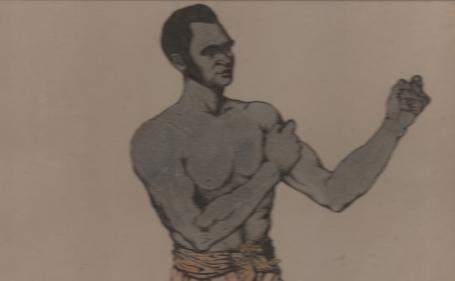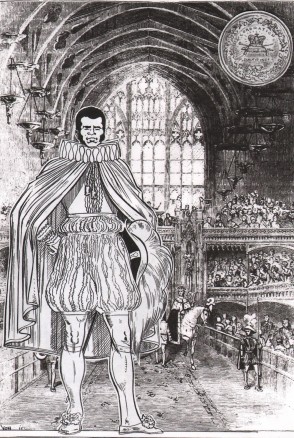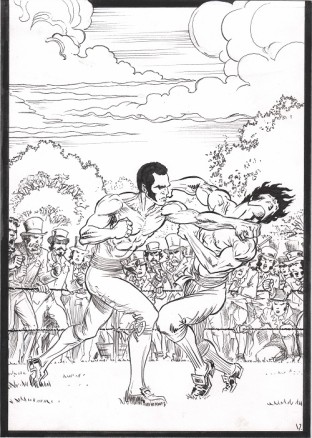
Yet the undisputed founding father of black sporting endeavour is none of the above. In fact, to trace the life of the first black sporting superstar, we must travel to America in the 1760s, during the turbulent days leading to the American War of Independence.
Bill Richmond was born into slavery on 8 August 1763 in Staten Island, an outpost of the British colonies to the southwest of Manhattan. By the end of his remarkable life, Richmond had left his origins as a slave far behind and earned unprecedented acclaim for a black sportsman.
Richmond did not achieve such fame in revolutionary America, but within the unlikely environs of Georgian England. The vehicle that enabled Richmond’s rise to prominence was boxing, a sport that united the lower and upper classes like no other leisure pursuit. So famous was he during the 19th century that his life was referenced in works of literature by writers such as William Hazlitt, Thomas Moore and Sir Arthur Conan Doyle, while his likeness appeared in popular prints by artists such as Richard Dighton and Thomas Rowlandson.

Richmond’s eventual life as a celebrity in England would have seemed utterly inconceivable when he was born. The youngster’s slave master was the Reverend Richard Charlton, rector of St Andrew’s Church in Staten Island, who, in an example of the hypocrisy typical of this period, saw no moral contradiction between gospel values and slavery.
The arrival of the British military in Staten Island in 1776 proved pivotal for the teenaged Bill, who endeared himself to General Hugh Percy, an English soldier famed for his kindness. Percy persuaded Charlton to release Richmond from slavery, brought the youngster to England and paid for him to be educated and then apprenticed to a cabinetmaker in York.
At this stage the black population of Britain was larger than many might imagine. Many black citizens had arrived after being promised freedom in return for fighting against the rebels in the War of Independence. Sadly, life for these new arrivals was usually characterised by poverty, with little prospect of advancement within a society hidebound by a strict social and ethnic hierarchy.
The well-dressed, literate and self-confident Richmond was an inevitable target for bigots. The regularity of the racial abuse he suffered while growing up was recounted by the leading boxing writer of the day, Pierce Egan, who described several occasions when Richmond became embroiled in brawls after being insulted, once after he was labelled a ‘black devil’ for being in the company of a white woman – probably a reference to Mary, who later became his wife and bore him several children.
On such occasions, Richmond would answer these taunts in the time-honoured manner of many an English gentlemen – with his fists in a makeshift boxing ring. By handing out a series of severe beatings, he taught his abusers, in the words of Egan, that it was wrong to discriminate against a man on “account of his country or his colour”.
Richmond’s reputation for his unique mixture of gentlemanly manners and imposing physicality soon spread. By 1795, he had moved to London, where he was employed by Lord Camelford, an aristocrat with a quick temper but generous heart. Several times Richmond visited prize fights in Camelford’s company and in January 1804 he issued an impromptu challenge to experienced boxer George Maddox. The seasoned Maddox was not the sort of boxer a novice should face in his first major contest, though, and Richmond was defeated.
A less determined man would probably have quit boxing but, after Camelford’s death in a duel, Richmond returned to the sport. Having discovered an aptitude for teaching, he began training and seconding other fighters and was soon a regular attendee at the Fives Court, London’s leading pugilistic exhibition venue.
By 1805 Richmond was on the comeback trail, defeating Jewish boxer Youssop and vanquishing contender Jack Holmes to secure a contest against highly touted Tom Cribb. Unfortunately, Cribb and Richmond’s counter-punching styles resulted in a dull bout, which Cribb won, leaving Richmond in tears. The contest solidified a grudge between the two men, which would last years.

Richmond didn’t box again until 1808, when several quick wins helped him land a dream fight – a rematch with Maddox. The contest, in August 1809, demonstrated Richmond’s mastery of ‘boxing on the retreat’. He battered Maddox mercilessly, earning the admiration of spectator William Windham, MP, who argued the skill and bravery on show were as impressive as that displayed by British troops in their triumph at the Battle of Talavera.
Richmond’s winnings enabled him to become landlord of the Horse and Dolphin pub near Leicester Square. It was here that he probably met Tom Molineaux, another former slave. Richmond immediately discerned Molineaux’s pugilistic potential and put his own boxing career to one side to train him, with a view to a challenge against Cribb, who was now champion.
Under Richmond’s tutelage, Molineaux demolished two contenders before squaring up to Cribb at Copthall Common in December 1810. It was an epic contest, and one of the most controversial bouts in boxing history – Cribb won, barely, amid the chaos of a ring invasion and whisperings of a long count that had allowed the champion longer than the allowable 30 seconds to recover in between rounds. Molineaux, many maintained, had been cheated.
Historians disagree about whether the alleged bias shown to Cribb was motivated by racism, nationalism or fears on the part of Cribb backers that they would lose their wagers. Certainly, before the fight there was nervousness about the prospect of a Molineaux victory, with the Chester Chronicle claiming that “many of the noble patronizers [sic.] of this accomplished art, begin to be alarmed, lest, to the eternal dishonour of our country, a negro should become the Champion of England!”
A rematch was inevitable but, by the time it happened in October 1811, Molineaux was past his best. Cribb won with relative ease and Richmond and Molineaux’s relationship was promptly severed. Having lost money brokering and betting on the fight, Richmond had to give up the Horse and Dolphin and rebuild. He became a member of the Pugilistic Club (‘PC’), the sport’s first ‘governing body’, and returned to the ring against Jack Davis in May 1814, despite the fact he was now fifty years old.
A handsome victory against Davis encouraged Richmond to accept his riskiest challenge yet – a contest against Tom Shelton, a fancied contender around half his age. After suffering a horrendous eye injury early on, Richmond wore Shelton down after twenty-three pulsating rounds, leaping over the ropes with joy to celebrate the defining moment of his career. “Impetuous men must not fight Richmond,” Egan declared, “as in his hands they become victims to their own temerity … The older he grows, the better pugilist he proves himself … He is an extraordinary man.”
Such achievements warranted a title shot, but with Cribb inactive, Richmond opted for retirement instead. His position among England’s leading pugilists was assured; he twice exhibited his skills for visiting European royalty and was among the most respected and admired of pugilistic trainers and instructors. Even more remarkably, Richmond was one of the pugilists selected to act as an usher at the coronation of George IV in 1821, earning a letter of thanks from Lord Gwydyr and the Home Secretary Lord Sidmouth. For a black man to be given such a role at an event symbolic of white privilege was astonishing, particularly considering slavery wasn’t outlawed in the British Empire until 1833.
Touchingly, Richmond’s former rival Cribb became a close friend in the last years of his life, the two men often conversing late into the night at Cribb’s pub, the Union Arms on Panton Street. It was here that Richmond spent his last evening, before he died aged 66 in December 1829.
Cribb planned to deliver a eulogy at Richmond’s funeral, but he was prevented from attending due to severe illness. A copy of the words he wrote has survived, though – using wording that is painfully clumsy to modern sensibilities, Cribb made a plea for racial tolerance, while also lauding Richmond’s character and conduct. Cribb’s insistence that all men were equally human flew in the face of mainstream opinion at the time, reinforcing Richmond’s remarkable achievement in earning fame during an age when understanding of non-white cultures was almost non-existent.
For this reason, as well as for his impressive feats in the prize ring, Richmond was not only the first black sportsman of significance, but also one of the greatest.
An appropriate epitaph for a man who combined the heart of a warrior with the temperament of a gentleman can be found in the words Richmond himself used when tutoring one of his many pupils. “A gentleman,” Richmond emphasised, “only uses his hands to defend himself, and not to attack; we call the pugilistic art, for that reason, the noble science of defence.”
Luke G. Williams is the author of Richmond Unchained: the biography of the world’s first black sporting superstar, published by Amberley. He maintains the Bill Richmond blog www.billrichmond.blogspot.co.uk
Link to book:
https://www.amberley-books.com/richmond-unchained-9781445644899.html
